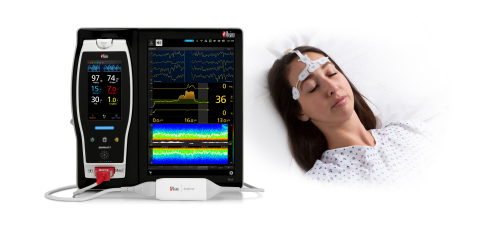IRVINE, Calif.--(BUSINESS WIRE)--Masimo (NASDAQ: MASI) today announced that in a new study published in Anesthesia Research and Practice, researchers used Masimo SedLine® Brain Function Monitoring to investigate the depth of anesthesia of patients receiving propofol for outpatient colonoscopy, concluding that, “Although providers planned for moderate to deep sedation, processed EEG [electroencephalography] showed patients were under general anesthesia, often with burst suppression. Anesthesiologists and endoscopists may utilize processed EEG to recognize their institutional practice patterns of procedural sedation with propofol and improve upon it.”
Noting that depth of sedation is “rarely quantified,” but that “the spectrum of sedation actually attained in gastrointestinal endoscopy procedures may extend to levels deeper than planned for, thereby exposing patients to…cardiorespiratory risks,” Dr. Jamie Bloom and colleagues at Thomas Jefferson University Hospital in Philadelphia sought to understand how frequently patients whose procedures called for moderate to deep sedation using propofol actually experience unintended general anesthesia and burst suppression. To quantify this, they monitored 119 adult patients undergoing outpatient colonoscopies using Masimo SedLine brain function monitoring, including its processed EEG index, the Patient State Index (PSi). PSi provides values that range from 0 to 100, with higher values indicating lesser degrees of sedation (with values from 50 to 25 indicative of general anesthesia, and below 25 for burst suppression). For the study, PSi values correlating to general anesthesia and burst suppression were confirmed by examination of the raw EEG by a neurointensivist and a neurophysiologist.
The researchers found that 118 of the 119 (99.1%) patients attained PSi values of <50, consistent with general anesthesia, and that these patients spent a significantly greater percentage of the procedure with PSi values <50 (53.1% of the time) vs. >50 (42% of the time) (p = 0.001). Of the 118 patients, 33 (27.7%) attained PSi values of <25, consistent with burst suppression. In addition, the researchers found the mean total dose of propofol was significantly correlated with PSi during periods of PSi values <25 (R = 0.406, p = 0.021).
Based on the study results, the researchers concluded, “The depth of sedation achieved with anesthesia administered propofol for colonoscopy spans a continuum. Although providers planned for moderate to deep sedation, processed EEG in this study revealed a substantially greater depth consistent with general anesthesia and even burst suppression.”
They continued, “Feedback from devices such as employed in this study to guide the depth of sedation may be considered to not only raise awareness of the physiologic implications of deeper levels of sedation but also to optimize institutional sedation practice. Further research is required to establish the impact on patient outcomes of anesthetic practices resulting in intraprocedural burst suppression.”
Patients receiving anesthesia during surgery can be over- or undersedated, both of which carry risks. When under-anesthetized, patients may have awareness during the procedure, which can be traumatic; when they are over-anesthetized, they may have alternating periods of no brain activity as measured by EEG, which is referred to as burst suppression.2 Burst suppression has been correlated with increased risk of postoperative delirium,3 which in turn has been shown to increase hospital length of stay and readmission rates, thus increasing costs.4 Burst suppression has also been associated with postoperative trauma, dementia, decreased quality of life, additional healthcare costs, and even death.3 In addition to burst suppression, overly deep sedation may result in loss of spontaneous ventilation and impaired cardiovascular function.1 Oversedation has also been associated with longer time on mechanical ventilation, longer time in the ICU, greater need for radiological evaluation of mental status, and a higher probability of developing brain dysfunction.2
The role of anesthesiologists in keeping patients appropriately sedated, and not over- or under-sedated, is critically important. Masimo SedLine has been shown to help anesthesiologists understand the patient’s sedation state using not only PSi values, but also through interpretation of the raw EEG and the Density Spectral Array that SedLine provides.4-6 In the current study, researchers showed that even in outpatient procedures, like colonoscopy, there is still a risk of patients being over-anesthetized, leading to burst suppression, which was identified using the PSi available as part of Masimo SedLine brain function monitoring.1
@MasimoInnovates | #Masimo
About Masimo
Masimo (NASDAQ: MASI) is a global medical technology company that develops and produces a wide array of industry-leading monitoring technologies, including innovative measurements, sensors, patient monitors, and automation and connectivity solutions. Our mission is to improve patient outcomes and reduce the cost of care. Masimo SET® Measure-through Motion and Low Perfusion™ pulse oximetry, introduced in 1995, has been shown in over 100 independent and objective studies to outperform other pulse oximetry technologies.7 Masimo SET® has also been shown to help clinicians reduce severe retinopathy of prematurity in neonates,8 improve CCHD screening in newborns,9 and, when used for continuous monitoring with Masimo Patient SafetyNet™ in post-surgical wards, reduce rapid response team activations, ICU transfers, and costs.10-13 Masimo SET® is estimated to be used on more than 200 million patients in leading hospitals and other healthcare settings around the world,14 and is the primary pulse oximetry at 9 of the top 10 hospitals according to the 2020-21 U.S. News and World Report Best Hospitals Honor Roll.15 Masimo continues to refine SET® and in 2018, announced that SpO2 accuracy on RD SET® sensors during conditions of motion has been significantly improved, providing clinicians with even greater confidence that the SpO2 values they rely on accurately reflect a patient’s physiological status. In 2005, Masimo introduced rainbow® Pulse CO-Oximetry technology, allowing noninvasive and continuous monitoring of blood constituents that previously could only be measured invasively, including total hemoglobin (SpHb®), oxygen content (SpOC™), carboxyhemoglobin (SpCO®), methemoglobin (SpMet®), Pleth Variability Index (PVi®), RPVi™ (rainbow® PVi), and Oxygen Reserve Index (ORi™). In 2013, Masimo introduced the Root® Patient Monitoring and Connectivity Platform, built from the ground up to be as flexible and expandable as possible to facilitate the addition of other Masimo and third-party monitoring technologies; key Masimo additions include Next Generation SedLine® Brain Function Monitoring, O3® Regional Oximetry, and ISA™ Capnography with NomoLine® sampling lines. Masimo’s family of continuous and spot-check monitoring Pulse CO-Oximeters® includes devices designed for use in a variety of clinical and non-clinical scenarios, including tetherless, wearable technology, such as Radius-7® and Radius PPG™, portable devices like Rad-67™, fingertip pulse oximeters like MightySat® Rx, and devices available for use both in the hospital and at home, such as Rad-97®. Masimo hospital automation and connectivity solutions are centered around the Masimo Hospital Automation™ platform, and include Iris Gateway®, Patient SafetyNet, Replica™, Halo ION™, UniView™, UniView: 60™, and Masimo SafetyNet™. Additional information about Masimo and its products may be found at www.masimo.com. Published clinical studies on Masimo products can be found at www.masimo.com/evidence/featured-studies/feature/.
ORi and RPVi have not received FDA 510(k) clearance and are not available for sale in the United States. The use of the trademark Patient SafetyNet is under license from University HealthSystem Consortium.
References
- Bloom J, Wyler D, Torjman M, Trinh T, Li L, Mehta A, Fitchett E, Kastenberg D, Mahla M, Romo V. High Incidence of Burst Suppression during Propofol Sedation for Outpatient Colonoscopy: Lessons Learned from Neuromonitoring. Anesthesiology Research and Practice. 2020;7246570. https://doi.org/10.1155/2020/7246570.
- Hughes, C, McGrane S, Pandharipande P. Sedation in the intensive care setting. Clinical pharmacology: advances and applications 4 (2012): 53.
- Fritz, B et al. Intraoperative electroencephalogram suppression predicts postoperative delirium. Anesth Analg. 122.1 (2016): 234.
- Hesse S et al. Association of electroencephalogram trajectories during emergence from anaesthesia with delirium in the postanaesthesia care unit: an early sign of postoperative complications. BJA 122.5 (2019): 622-634.
- Purdon P et al. Clinical electroencephalography for anesthesiologists part I: background and basic signatures. Anesthesiology. 123.4 (2015): 937-960.
- Sayed E, Refaat E, Yassen K. SedLine Monitored Sedation and Recovery for Postoperative Ventilated Recipients of Living Donor Liver Transplantation: A Randomized Controlled Trial. J Anesth Clin Res 6.530 (2015): 2.
- Published clinical studies on pulse oximetry and the benefits of Masimo SET® can be found on our website at http://www.masimo.com. Comparative studies include independent and objective studies which are comprised of abstracts presented at scientific meetings and peer-reviewed journal articles.
- Castillo A et al. Prevention of Retinopathy of Prematurity in Preterm Infants through Changes in Clinical Practice and SpO2 Technology. Acta Paediatr. 2011 Feb;100(2):188-92.
- de-Wahl Granelli A et al. Impact of pulse oximetry screening on the detection of duct dependent congenital heart disease: a Swedish prospective screening study in 39,821 newborns. BMJ. 2009;Jan 8;338.
- Taenzer A et al. Impact of pulse oximetry surveillance on rescue events and intensive care unit transfers: a before-and-after concurrence study. Anesthesiology. 2010:112(2):282-287.
- Taenzer A et al. Postoperative Monitoring – The Dartmouth Experience. Anesthesia Patient Safety Foundation Newsletter. Spring-Summer 2012.
- McGrath S et al. Surveillance Monitoring Management for General Care Units: Strategy, Design, and Implementation. The Joint Commission Journal on Quality and Patient Safety. 2016 Jul;42(7):293-302.
- McGrath S et al. Inpatient Respiratory Arrest Associated With Sedative and Analgesic Medications: Impact of Continuous Monitoring on Patient Mortality and Severe Morbidity. J Patient Saf. 2020 14 Mar. DOI: 10.1097/PTS.0000000000000696.
- Estimate: Masimo data on file.
- http://health.usnews.com/health-care/best-hospitals/articles/best-hospitals-honor-roll-and-overview.
Forward-Looking Statements
This press release includes forward-looking statements as defined in Section 27A of the Securities Act of 1933 and Section 21E of the Securities Exchange Act of 1934, in connection with the Private Securities Litigation Reform Act of 1995. These forward-looking statements include, among others, statements regarding the potential effectiveness of Masimo SedLine®. These forward-looking statements are based on current expectations about future events affecting us and are subject to risks and uncertainties, all of which are difficult to predict and many of which are beyond our control and could cause our actual results to differ materially and adversely from those expressed in our forward-looking statements as a result of various risk factors, including, but not limited to: risks related to our assumptions regarding the repeatability of clinical results; risks related to our belief that Masimo's unique noninvasive measurement technologies, including Masimo SedLine, contribute to positive clinical outcomes and patient safety; risks related to our belief that Masimo noninvasive medical breakthroughs provide cost-effective solutions and unique advantages; risks related to COVID-19; as well as other factors discussed in the "Risk Factors" section of our most recent reports filed with the Securities and Exchange Commission ("SEC"), which may be obtained for free at the SEC's website at www.sec.gov. Although we believe that the expectations reflected in our forward-looking statements are reasonable, we do not know whether our expectations will prove correct. All forward-looking statements included in this press release are expressly qualified in their entirety by the foregoing cautionary statements. You are cautioned not to place undue reliance on these forward-looking statements, which speak only as of today's date. We do not undertake any obligation to update, amend or clarify these statements or the "Risk Factors" contained in our most recent reports filed with the SEC, whether as a result of new information, future events or otherwise, except as may be required under the applicable securities laws.




